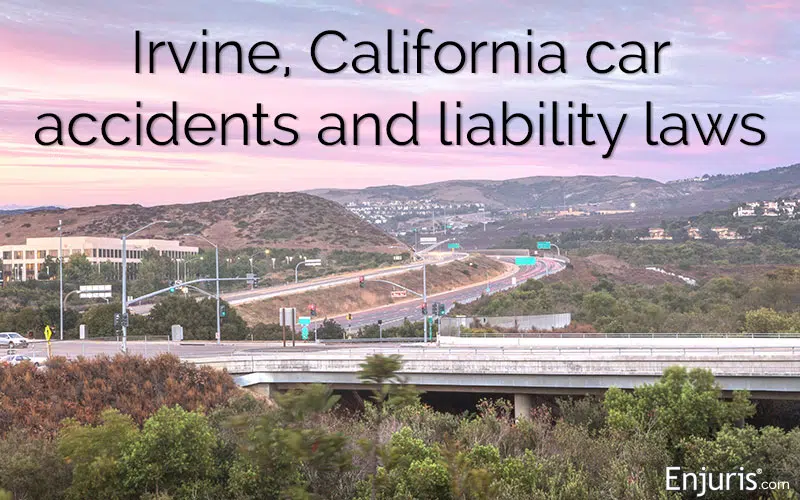
A rear-end collision is the most common type of collision in the United States, according to the National Highway Traffic Safety Administration (NHTSA). These collisions are responsible for roughly 29 percent of all car accidents and collisions.
You’ve probably been told that the rear driver is always liable for a rear-end collision, but the truth is more complicated than that.
Let’s take a close look at rear-end collisions and car accident liability in California.
California has a fault-based insurance system
There are two primary types of auto insurance systems in the United States:
- Fault-based insurance systems. In states that follow a fault-based insurance system, car accident victims receive compensation from the at-fault party or their insurance company.
- No-fault insurance systems. In states that follow a no-fault insurance system, all drivers involved in an accident—regardless of who’s at fault—turn to their own insurance company to cover their car accident damages. In most no-fault insurance systems, it’s not possible (or typically necessary) to sue the other party for damages.
California follows a fault-based insurance system. This means that if you’re involved in a rear-end collision on California’s roads, you have 3 options to recover damages:
- File an insurance claim with the at-fault driver’s insurance company,
- File a personal injury lawsuit against the at-fault driver, or
- File an insurance claim with your own insurance company (in which case your insurance company will seek reimbursement from the at-fault driver’s insurance company).
On the other hand, if you’re responsible for a rear-end crash, a claim will be made with your insurance company, or you’ll be sued for damages (in which case your insurance company will defend you so long as the accident may be covered by your policy).
3 Simple Methods to Prove Fault in a Car Accident
Proving fault in a car accident case is a matter of examining the accident scene, reviewing police records, speaking with witnesses, and seeing where the incident falls under codes and regulations.
Determining fault in a California rear-end collision
Under California law, a presumption of negligence arises when a motor vehicle driver violates a statute and an accident results.
In rear-end collisions, the rear driver has often violated one of the following California statutes:
- The statute prohibiting drivers from speeding or driving too fast for road conditions
- The statute prohibiting drivers from following other vehicles more closely than is reasonable and prudent
- The statute prohibiting drivers from texting while driving
- The statute requiring drivers to maintain their vehicles (this includes keeping tires and brakes in good working order)
As a result, the rear driver in a rear-end collision is typically presumed to be negligent. However, this presumption is rebuttable. In other words, the rear driver may escape liability by showing evidence of a legally-recognized excuse or defense.
The most common defense raised by the rear driver in a rear-end collision is that the front-end driver was responsible or at least partially responsible for the accident.
Here are some examples of situations in which the front-end driver may be held responsible or partially responsible for a rear-end accident:
- The front-end driver pulled out in front of the rear driver.
- The front-end driver braked suddenly without reasonable cause.
- The front-end driver made an unsafe lane change.
- The front-end driver backed up into the rear driver.
- The front-end driver turned on their turn signal and stopped their car but didn’t turn.
- The front-end driver’s vehicle broke down and they didn’t pull to the side of the road.
- The front-end driver had a broken tail light or brake lights.
California’s comparative fault system in rear-end crashes
California is a pure comparative fault state. This means that plaintiffs can still recover damages even if they’re 99 percent at fault for the accident. Their damages will, however, be reduced by their percentage of fault.
Consider the following example:
Marcos is texting and driving along Sand Canyon Avenue in Irvine, California.
Laura is driving behind Marcos. She’s in a hurry to get to work, so she’s tailgating Marcos in an effort to get him to drive faster.
Because Marcos is texting and driving, he doesn’t see a dog dart into the road until the last second. Marcos slams on his brakes and Laura crashes into him.
Laura sustains a neck injury and sues Marcos for $10,000.
In the above hypothetical, a jury might reasonably find that Marcos was 30 percent at fault for the crash (for texting and driving) and that Laura was 70 percent at fault for the crash (for following too closely). Under California’s comparative fault system, Laura would only be allowed to recover $3,000.




 Irvine personal injury law firm, MVP Accident Attorneys advocate for injured clients to recover compensation for losses from California car accidents, slip-and-fall accidents, brain injuries, spinal cord injuries, and other personal injuries. Our team will work tirelessly for you, whether it’s recovering economic damages like costs for medical treatment, non-economic damages for outcomes like emotional trauma, or even punitive damages. MVP Accident Attorneys is the official law firm of the LA Galaxy.
Irvine personal injury law firm, MVP Accident Attorneys advocate for injured clients to recover compensation for losses from California car accidents, slip-and-fall accidents, brain injuries, spinal cord injuries, and other personal injuries. Our team will work tirelessly for you, whether it’s recovering economic damages like costs for medical treatment, non-economic damages for outcomes like emotional trauma, or even punitive damages. MVP Accident Attorneys is the official law firm of the LA Galaxy.